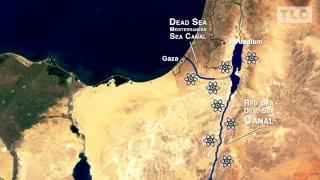April 17—The broader implication of Iran’s April 14 drone and missile strike against Israel—which was launched in response to Israel’s April 1 destruction of Iran’s consulate in Damascus, Syria and the killing of several top Iranian military leaders—is a game-changer which has brought the world to a breakpoint. Either we use this moment of maximum danger to bring about a development-based solution and paradigm shift for Southwest Asia and the world, or we face the rapidly escalating danger of nuclear Armageddon. The widest possible, immediate distribution of the video and written report summarizing the historic April 13 Schiller Institute conference on LaRouche’s Oasis Plan for Southwest Asia is decisive to shaping that outcome for the Good.
That was the central message, and marching orders, delivered by Schiller Institute founder Helga Zepp-LaRouche in her weekly Dialogue webcast on April 17.
“Sometimes things have to get really bad before people are willing to consider that a change is necessary,” Zepp-LaRouche began. She pointed to a series of articles by qualified military and strategic analysts—including Judge Andrew Napolitano’s interview with former British diplomat Alastair Crooke; former UN weapons inspector Scott Ritter’s April 14 piece “The Missiles of April”; and retired Army Col. Douglas Macgregor’s analysis—which, “if you evaluate all of these together, then it is very clear that … we have reached a point where Israel is clearly confronted with a situation where a change is necessary. The Oasis Plan at this moment shows Israel a way out.”
Zepp-LaRouche continued: "Israel did not accomplish what it set out to do. Hamas is not destroyed. Israel’s reputation around the world is severely damaged; it’s practically hopeless. After the Iranian attack with 300 drones, missiles, cruise missiles, a new situation has arisen. Scott Ritter, in particular, who after all was a weapons inspector and I trust his judgment quite a bit in this respect, makes the point that [Iran’s initial deployment of slow-moving drones] was meant primarily for mapping the Israeli air defense, which he and others claim was thoroughly accomplished.
“But then, despite the fact that the U.S., maybe the U.K. too, and Israel had the most sophisticated missile defense systems around their air bases in the Negev desert—both nearby and also on ships and possibly on airplanes—nevertheless nine Iranian missiles were able to penetrate this missile defense and impact on those air bases. Ritter makes the point that that means the entire myth of U.S. ballistic missile defense systems is practically ruined. Because if the Iranians can do that, where you have the most developed and sophisticated American and Israeli missile defense, then that can be replicated anywhere. At no point in the world are these systems able to protect what they are supposed to protect, including U.S. ships in the Pacific.”
Zepp-LaRouche noted that the U.S., the Russians, the Chinese, the Iranians and possibly other nations fully understand that this has enormous strategic implications. She added:
“Douglas Macgregor, who is after all a key military expert as well, says there is the danger that Israel would use nuclear weapons in a coming confrontation with Iran. And, obviously, that would mean complete Armageddon.”
“The alternative,” Zepp-LaRouche stated, “is very clearly to say: Let’s go to a completely new paradigm. We [in the Schiller Institute] have proposed a very reasonable approach: the Oasis Plan. This is the idea of development for everybody, that every side will have a safe future,” as was elaborated in detail at the April 13 conference.
“Armageddon or peaceful development, there is no third way,” Zepp-LaRouche concluded. “We have reached the end of the road in that respect, and I think that is why I think this conference was extremely important and an absolute success,” and should be immediately distributed as widely as possible.
An identical approach must also be applied to the war in Ukraine, Zepp-LaRouche emphasized. It is precisely at the moment of maximum danger that the greatest opportunity arises to bring a new strategic paradigm into existence.






